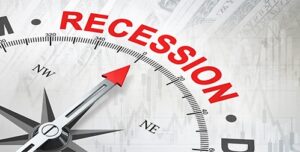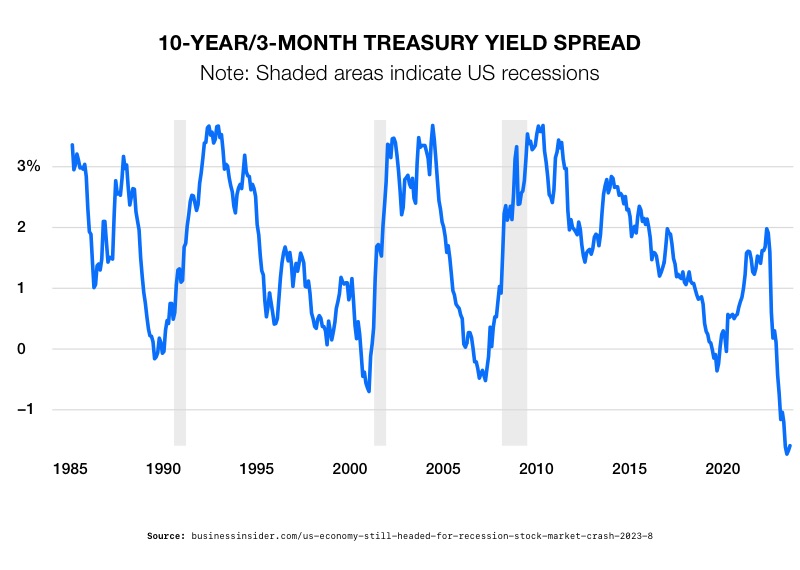- Despite trader optimism, economists point to strong recession indicators
- The recession has been delayed by stimulus money and rate hike effect lag
- The S&P 500 potentially faces more than a 30% drop
Indicators Still Point to Recession
When it comes to recession, bullish economists are eager to say, “I told you so,” pointing to low unemployment, strong consumer spending and an S&P 500 rally. But top Wall Street strategists believe now is not the time to gloat. A recession is on the way.
Forecasters began warning of recession and a stock market sell off back in April 2022. By October 2002, 65% of economists said recession would arrive in 12 months. They based this on the Fed’s rapid rate hikes. The Fed’s goal was to tame record inflation by contracting the economy. The Fed raised rates from near zero to 5.5%. This hiking cycle is the fastest and most aggressive since the early 1980s. Since World War 2, 80% of Fed hiking cycles have resulted in a recession.1
As the bulls point out, the economy seems to have avoided the drop in earnings and rise in unemployment – so far. The reason for this, according to economists, is due to the lingering effects of the massive fiscal and monetary stimulus efforts during the COVID-19 pandemic. As well as the long lag time before the Federal Reserve’s rate hikes filter through to the economy. Even Fed chair Powell admitted as such. He said, “We have covered a lot of ground, and the full effects of our tightening have yet to be felt.”2
There was nearly $5 trillion in stimulus disbursed. It went to households and businesses, as well as state and local governments. The cushion allowed people to keep spending and ignore higher interest rates. But that is starting to change. Cash reserves are being used up. The number of Americans falling behind on credit card debt is on the rise. Credit card delinquencies have almost doubled since 2021. Auto loan and mortgage delinquencies are also on the rise.
And though inflation seems to have plateaued, prices haven’t come down. Consumers will soon be forced to cut back on spending. Tom Essaye is the founder of Sevens Report Research. He explains it this way – “People get very excited about CPI and say, ‘Hey, CPI went up only 0.1% over the past month and it’s only up 3% over the past year. Well, think about that in practical terms. If I go to buy my kids a bag of Skittles, in 2019 it cost $0.75. Now it costs $1.50. Am I supposed to get excited because next year it costs $1.55?”3
Another reason a recession is considered imminent is the lag time between rate hikes and their effects. This is visible in the manufacturing sector. Industrial production is starting to trend downward. The Institute for Supply Management’s Purchasing Managers Index shows there is widespread worry across the industry. The downward trend reflects dropping consumer demand. Manufacturing is considered a thermometer for the broader economy.
Another lagged effect of the rate hikes is the impact of tighter lending standards. A recent survey showed more than half of banks are making it harder for businesses to get loans. Banks are growing more concerned about borrower’s ability to pay them back. These loans are vital for companies to grow and pay employees. When the money stops, businesses contract and unemployment rises.

Reliable Recession Signal
Economists point to the Treasury yield curve as evidence that a recession is on the way. The Treasury yield curve measures the different interest rates that are paid out on various bonds issued by the US government. Usually, the interest rate on short-dated Treasuries is lower than yields on far-out bonds like the 10-year Treasury. But when that flips and interest rates on short-term Treasuries are higher than their long-term cousins, it is known as a yield-curve inversion. Since the 1960s, the indicator has a perfect track record of preceding recessions.
 4
4
The message of an inverted yield curve is that while interest rates are high now, in the future, the rate of economic growth and inflation will be slower. Interest rates will then be lower. Historically, it has taken a recession to realize such a scenario. The extent of the current inversion is extreme by historical standards. It is at its widest gap since the 1982 recession.5
Recession Impact and Recourse
If the recession is mild, analysts see the S&P 500 likely falling as much as another 13%. But in the past 13 recessions, the S&P 500 has dropped an average of 32%, as noted by the Royal Bank of Canada.6
People can choose to remain optimistic and hope that there will be a soft landing with no recession. Or they can see the financial data and prepare for an economic downturn. methods One of preparation is shifting part of your portfolio into recession resistant assets like physical precious metals. In fact, the Gold IRA from American Hartford Gold is designed to shield portfolio value from recession. Contact us today at 800-462-0071 to learn more.





